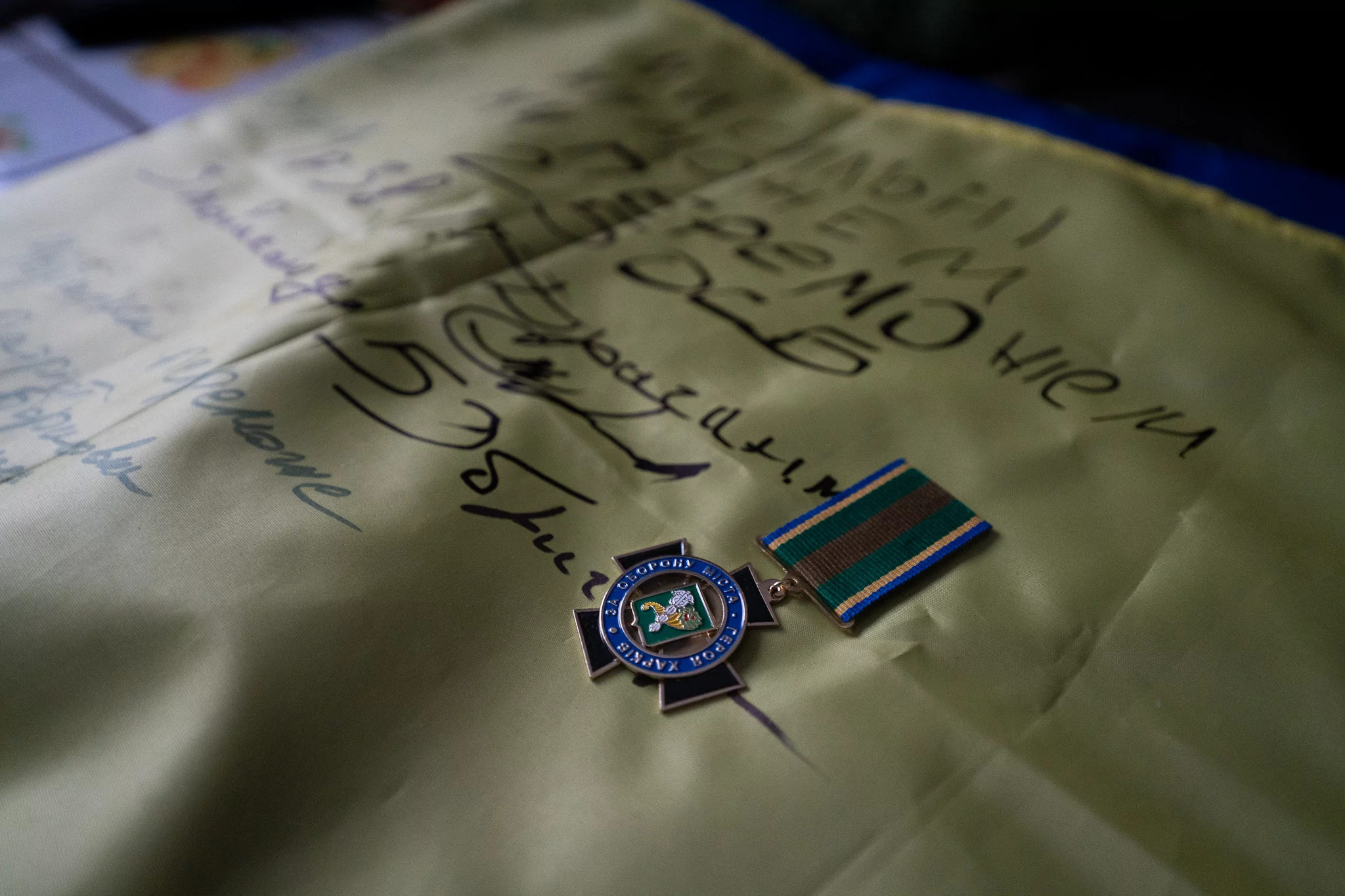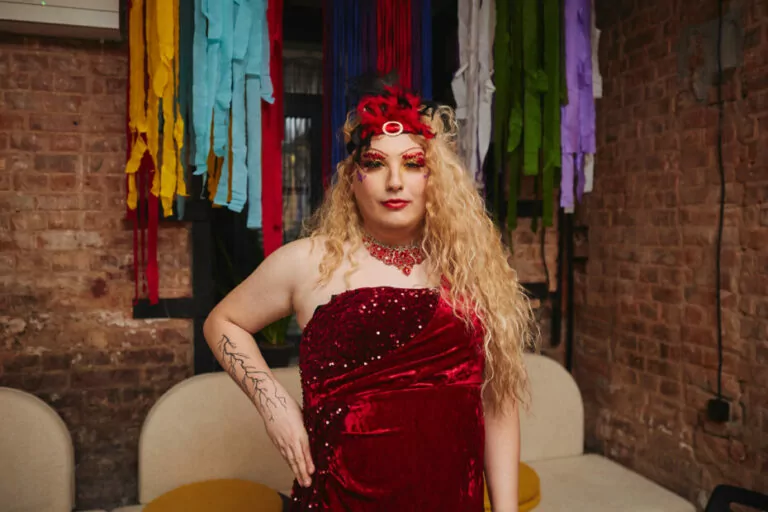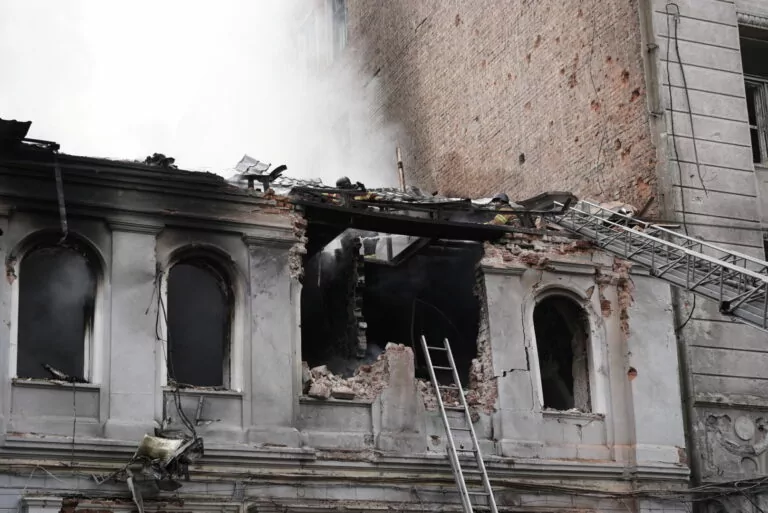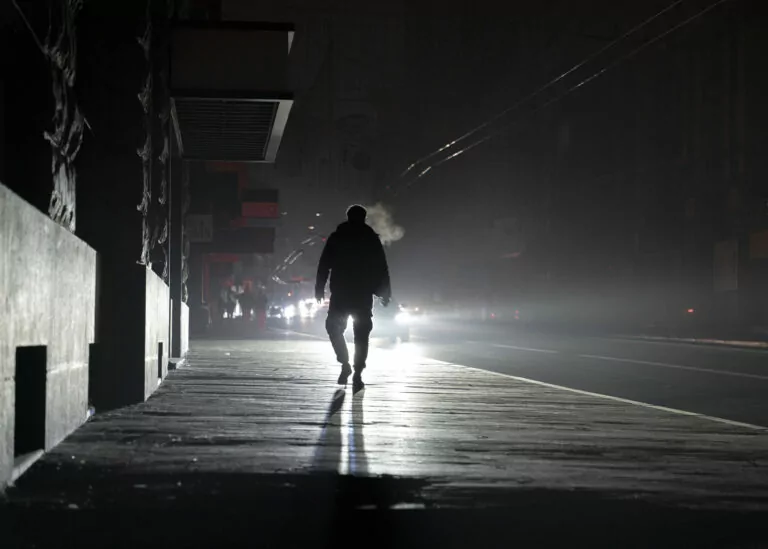— “Do you have the inscription ‘Luhansk’ on your ring?” Our photographer Sasha asked before taking the photo.
— “Yes, Calcide smiled. I have an interesting story about it.”
His brother and colleagues gave him a ring. Calcide asked his friend from Vinnytsia to engrave a chevron on it. In the center of the chevron on the ring is a symbol of the city – a memorial to the Luhansk worker.
They were both born in Luhansk, but had to leave: Calcide – because of the lack of work, his friend – because of the war.
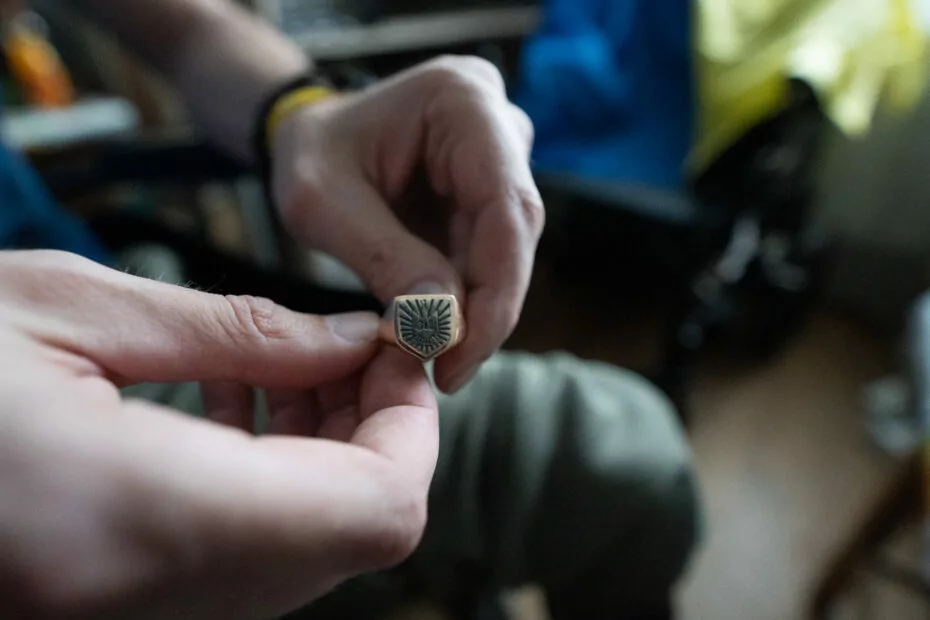
— I dreamed of returning home one day. Last year, I realized that I could only do it in armor.
Before the full-scale invasion, Calcide was an engineer repairing refrigeration equipment at industrial facilities. In March, he joined the Kharkiv Territorial Defense Forces. At 4 a.m. on July 29, a Russian missile hit the battalion’s location, and Kalсide was in the building.
— All I remember is a bang, and that was it. Then the unpleasant sound of an ambulance siren. I remember that when they were pulling me out from under the rubble, I tried to say something. I don’t even know if I managed to do it – my right lung was just rolled up. They asked if there were any people nearby. Then I remember being pricked with something – and three days later, I regained consciousness. Above me were three or four doctors. I asked what was wrong with my legs. They answered: “It’s okay – they are gone.”
February 24. Kharkiv. How the full-scale invasion began for Calcide
— On February 24, I was preparing for work: I had a lot of materials and tools at home. The car that was supposed to take me to the site could not come because it was in the occupied village. I called to ask why no one came to pick me up. They said that work at the facility was canceled because of the war. That was the beginning of the full-scale invasion for me.
March 18. Joining the territorial defense of Kharkiv
— In March, I was stopped near a supermarket and asked if I wanted to join the ranks of the terrorist defense. There was no job, but there was an enemy, so I decided to defend the country.
I came to the appropriate place. There were about 30 guys there besides me. Some went in the morning, others a little later. We waited together until they said: “If you are not picked up by five o’clock, you can go home and wait for a call.” We stood there until half past six in the evening, and then they came to pick us up to take us to the collection point. Everyone had already met there. It was interesting [he smiles].
July and August 2022. Kharkiv – Kyiv – Vinnytsia. Diagnosis: gunshot shrapnel wounds to the head, torso, and limbs
— First, I was taken by ambulance to a hospital in Kharkiv. There I had a blood transfusion – I lost a lot of blood. For four days, I was brought to a stable condition. Then I was taken to the train station in an ambulance, and from there, I and 39 other guys in serious condition were taken to the main military hospital in Kyiv. We were placed in different hospitals. I had to undergo two days of intensive care, four surgeries, two months to bring me back to medium condition, and another three weeks to light condition. Later, I was sent to Vinnytsia for an examination to start preparing for prosthetics.
August 2022. Kyiv. Preparing for prosthetics
— I began preparing in Kyiv. There were doctors from the Red Cross: one of them is called Iran, I don’t remember his last name. He is a cheerful guy.
Junior medical staff also prepares for the installation of prostheses. I’m very grateful to them because an ordinary nurse taught me how to transfer to a wheelchair from my bed. Even before physiotherapy, I had such a bad habit – smoking. I had to go outside when I wanted to smoke, but I had nothing to run on. The nurse had to help me with a sheet to transfer to a gurney, which didn’t even fit in the elevator. There is a whole story there. She approached me one day and said: “You waved me off. Here’s a wheelchair for you – I’ll show you once.” At first, he almost fell, but later he learned to move independently.

Autumn. Vinnytsia region. Calcide was training to move on prostheses
— We stayed in Vinnytsia for a week or two; then we were sent to a military hospital in Vinnytsia region. A military medical commission met to determine the degree of painful shock there. They do a course, if necessary, to form a stump (a part of the limb that remains after amputation – ed.) And then they give a referral to a prosthetic center. There are two prosthetic centres in Vinnytsia itself: one is private and the other is public. There is absolutely no difference, I can tell you right away because people have questions. The only difference is that in the state one, you have to do exercises, and in the private one you can do them if you want. It all depends on the person and their mental state. If you want to return home quickly, there are no questions: train; everything is at your fingertips.
How it happened: I arrived at a private enterprise, and we were settled in the wards. The next day, the documents were drawn up, and on the third or fourth day, a foreman came to work directly with me. Everyone was assigned their specialist. He took measurements and came back the next day to take casts.
Within a week, I had my training prostheses ready. I trained on them. At first, it was hard: firstly, they were not adjusted, and secondly, I spent almost four months in a wheelchair. When you stand up, you get dizzy from the height. Learning to keep my balance on the prostheses took me about a week. I spent another month getting used to the training devices.
I have one knee. However, for some reason, guys who don’t have both knees learn to walk faster. Those with at least one leg are lazy because they can move around with crutches.
A month later, the training was over. I was sent back to that hospital in the region for rehabilitation. There, I again underwent a course of MMC (military medical commission – ed.) and physiotherapy. It was a huge base, even a swimming pool. I stayed there for a month, then they sent me back to the prosthetics unit because after wearing prostheses, the stumps dried out. There, they make permanent knots depending on the class of mobility. There are lightweight prostheses and slightly heavier ones adjusted to the person’s activity. It depends on how long it will take them to return from abroad. Some people get theirs in two weeks, others – in a month at the most.
All rehabilitation takes place at the hospital. I will say that there are two dinners to encourage someone [smiles]. The food is delicious.
February 2023. Vinnytsia – Kyiv – Kharkiv. Calcide returns home
— My brother picked me up by car. I could have gone by train but couldn’t have got on the train with my prostheses, strollers, and things. I made an appointment with the doctor and waited for them to pick me up.
My brother arrived in a Renault Kangoo. There was almost no room in it – we were carrying strollers, prostheses, and piles of clothes because I arrived at the end of summer and was returning home in winter. We drove to Kharkiv via Kyiv, where we stopped for the night. I didn’t want to spend a day on the road.
How does Calcide take care of dentures?
— It is not complicated. Foremost, it would be best if I kept up with hygiene. I remove the prosthesis myself and treat it from the inside with wet wipes or antiseptic.
If I have any problems, I can contact the center. Of course, if my laces come untied, I won’t call them for help [smiles]. But if, for example, my knee gets jammed or the hydraulics leak, it makes sense to contact the center. If necessary, they will send a car. But I could fix the prostheses myself if I had a screwdriver. I can even use electrical tape [laughs].
Getting around the city. What problems do people with prostheses face?
— I use an electric wheelchair to get around the city. I call it Tesla [smiles]. Unfortunately, there are no ramps and handrails on stairs everywhere. For instance, at the entrance of my house. However, we will solve this issue: a friend of mine will come to my place and we will make handrails.
It’s actually not a big issue because my neighbors usually help me take the pram outside, and I follow.
The wheelchair was given to me by volunteers in Kyiv, and the electric one was sent from America. The support of volunteers is powerful. When I left the Kharkiv hospital, my comrades brought me a phone, underwear, T-shirts, and even socks. I don’t know why [laughs].
Help from the state with prosthetics
— The state paid for everything. I could go abroad: to Germany, France, and the UK. Unfortunately, or fortunately, I refused because prostheses take time to maintain. Why would I go there if the same components are made in Ukraine? The same elements, the same materials, everything is the same. I am also provided with other prostheses and covers for them. There are four of them in the set. There is a lot more stuff: bandages, belts, etc.
I am concerned about problems with the bureaucracy: until I confirm my disability, I am in a “suspended” state. Before applying to the housing office for a wheelchair ramp, I must provide a document confirming my disability. This red tape has been going on since Soviet times. However, I think it will be fixed quickly.
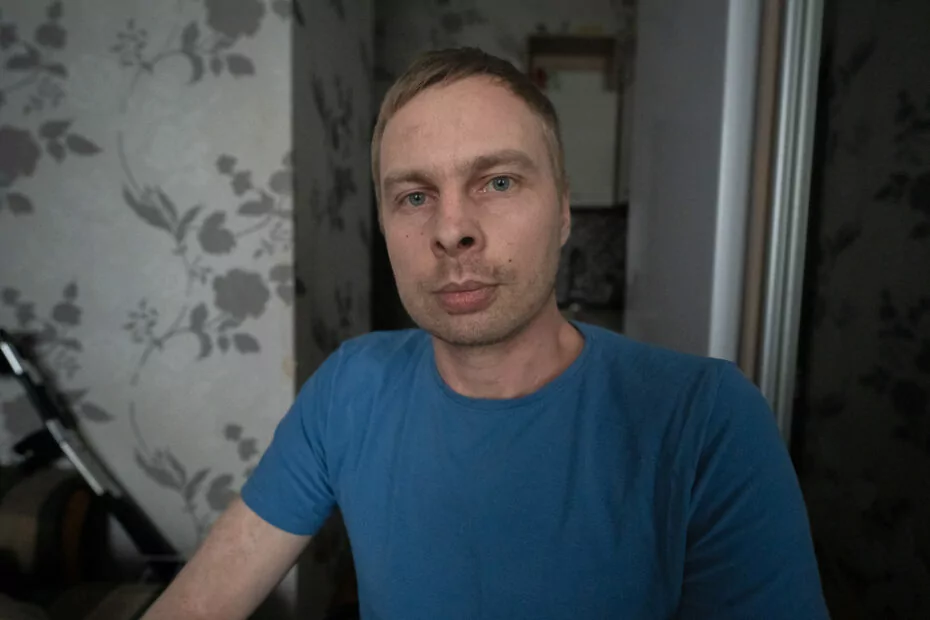
— The commission does not last long, but I must visit many doctors to pass it. I spend a lot of time in queues and must pass the commission in three clinics. If I didn’t have transport, I couldn’t do it physically. At this stage, there is no support from the state.
Lenka was with me all the time in Kyiv. This is her call sign. For three months, she was the only one who motivated me. This girl is my hero, Lenka was by my side at the most challenging moments of my treatment. She is the only person who keeps me alive.
Signatures on the flag. Calcid about his brothers-in-arms
— I feel a lot of support. Firstly, we are constantly in touch. I know they have a complicated situation at the front, so I try to support them morally. Even financially in the future. In addition, I communicated with the guys who had prosthetics with me. I have a flag with the signatures of my comrades, but not everyone has signed it yet. I will meet with my comrades, and they will fill in the empty spaces.
Everyone who signed the flag has to respect and support each other. This is not even up for discussion. We are brothers in arms.
Calcide on plans
— I made plans for the future when I first came to my senses. There is such help from the state as a one-off payment. I want to buy a house with this money and set up a farm where I will build a private brewery.
My brother and I want to brew craft beer, and we can feed chickens with the waste, i.e. grain. They provide meat and eggs. Chickens are also humus, which can be used to make biogas. If we install a reactor, it will heat the brewery. So it’s a closed cycle. Nothing else needs to be done; everything is already calculated. The only thing is that the licence is expensive.
Depending on the degree of health loss a person sustained while performing a combat mission, one of three disability groups is established:
- Disability group I – a person who has completely lost the ability to work and requires constant care (one-time payment of UAH 1,073,600 / $29,063).
- Disability group II – a person is capable of self-care but not of working in normal production conditions (one-time payment of UAH 805,200 / $21,800)
- Disability group III – a person who can work in light conditions (one-time payment of UAH 671,000 / $18,200).
Do you plan to return to Luhansk after the war?
— Probably not anymore. I don’t see the point. My life is getting better here. Why would I go back there? You have to start from scratch there. It’s not for me.
And what about engineering?
— I’m returning a little bit – I can make electrical cabinets at home. Nothing hinders me – there are minimal tools. When I was in Kyiv, I set up cabinets at the control room. Now there are problems with the components for the work, so I have to travel all over Ukraine to collect them.
I have my hands and head to work with – I don’t need anything else.
See also
- One day of rebuilding a life with family in Ruski Tyshky in Kharkiv Oblast. This is a settlement approximately 25 km from Kharkiv. The occupiers used it for two months as a springboard for attacks on Ukrainian cities until the Ukrainian army liberated the village on May 5-6, 2022.
- One year in captivity: Kyiv holds a rally to commemorate the release of defenders from Azovstal. The defenders of Mariupol who left Azovstal have been in Russian captivity for a year now, where they faced only torture, abuse and death.
- Constant missile attacks and empty streets: how Kupiansk lives on the front line. The city was severely damaged at the beginning of the full-scale invasion and during the battle for its liberation in September 2022. Today, it is constantly under fire from Russian MLRS and S-300 systems.
